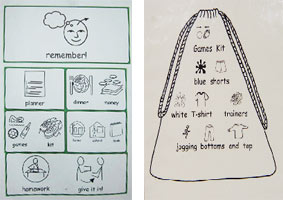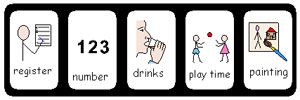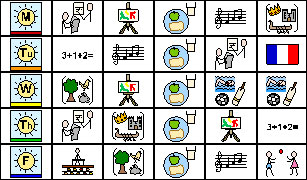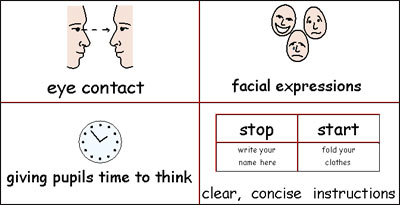Communication Friendly Environments
Examples of C.F.E
From Warwickshire County Council, Children,Young People and Families Division
The following is taken from a booklet giving examples of how to make sites 'Communication Friendly'. The booklet can then be personalised by schools and settings to fit their individual needs.
Download full copy of the CFE booklet.pdf
This school is developing a Communication Friendly Environment (C.F.E.) where everyone feels safe enough to:
- listen,
- understand,
- express themselves.
Ways in which a C.F.E. can help everyone to be independent
Information is clearly available about:
- who works in the school,
- where they work and how to get there.

A map of the school site is available using consistent colour coding.

The entrance foyer has photographs of staff with:
- their names,
- their responsibilities.
Plastic wallets are used so that photographs can be changed as required.

There are clear directions to specific areas using consistent colour coding.

All staff use either real objects, photographs or symbols with text to explain regular routines. This will include:
- getting the right equipment for a lesson,
- getting ready for P.E.

Timetables are clearly displayed and referred to. Staff use a visual timetable either with photos or symbols showing the activities for the day. This will reduce anxiety about what is happening and help make everyone feel safe.

A visual timetable showing the structure of a morning.

A visual timetable showing the structure of a week.
Staff adapt their language
Staff help pupils pay attention to what is said by:
- slowing down their language,
- emphasizing the important words,
- simplifying their language,
- reinforcing important concepts with real objects, photographs or symbols,
- giving the pupils time to think,
- always using the pupil's name.

When speaking, staff may add a simple gesture or sign.
To maintain interest when reading a story, staff show relevant pictures and objects. This gives an opportunity to link something real to the spoken word. It makes the story come to life.

The teacher adapts his/her presentation according to the environment and situation by the appropriate use of:

Active listening skills are taught and reinforced
- good sitting,
- looking at the person who is speaking,
- thinking about the same thing as the speaker.
Survey of the Environment
- There is a good acoustic environment.
The teacher's voice can be easily heard. - Materials and resources for tasks are readily available.
- There is sufficient space on the table for children to work.
- There is good light.
- The temperature is comfortable.
- There is an awareness of visual distractions.
Pupils demonstrate their knowledge in a variety of ways

Using symbols and words together can provide useful 'stepping stones' in developing the following areas:
- literacy,
- numeracy,
- memory,
- vocabulary,
- independent actions.
C.F.E | Visual Support | Communication | Environment | Examples

